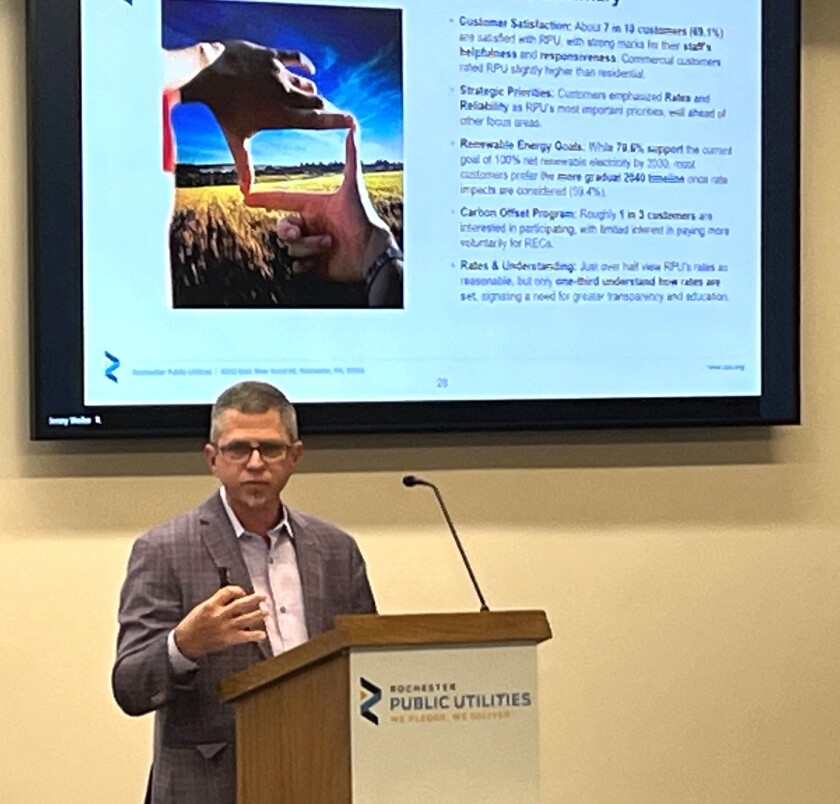Survey supports Rochester’s renewable energy plan, with a slower approach
September 30, 2025
ROCHESTER — The Rochester Public Utilities goal to achieve 100% net renewable electricity by 2030 was reaffirmed Tuesday, following a survey showing 70.6% of participants support the effort.
“When it comes down to the question of pacing and cost, there’s a slight preference – about 60% – that said to go a little bit slower and try to mitigate the cost impacts,” RPU General Manager Tim McCollough said.
Rochester’s Public Utilities Board voted unanimously Tuesday to maintain the goal,
which was initially adopted in 2019.
Members also voiced support for finding ways to adjust potential expenses in the near future.
“It’s been tough, because we are talking about two different issues that I feel strongly about,” Board Vice President Wendy Turri said of committee work on the proposal.
The customer survey launched in August, with emails sent to 47,000 customers.

Randy Petersen / Post Bulletin
Seamus McNamee, vice president of Great Blue Research, said the plan was to try other approaches, if fewer than 500 responses were received. With 1,819 residential customers and 60 businesses responding, he said the results provided good insight for the RPU board.
However, McCollough pointed out the potential rate impacts outlined in the survey have changed since the survey was initiated.
The original questions were based on an assumption that
RPU could reduce proposed 6% electric rate increases
for 2026 and 2027 to 4%, if the renewable energy goals are scaled back.
McCollough said today the potential rate increases in the questions would be 6% and 8%, due to new energy cost projections.
When the 4% and 6% rate adjustments were discussed in early August, McCollough said the potential RPU revenue difference was roughly $10 million to the base rate over a two-year period, which likely won’t cover periodic increases in the cost of purchasing electricity supplied to Rochester residents.
As a result, the proposed 6% rate increase is intended to reduce future fluctuations in customers’ monthly bills.
“What we collect through the base rate, can help mitigate the power cost adjustments,” he said of added costs that can be spurred by increased demand.
McCollough said an 8% rate increase would be required to secure enough renewable energy by 2030 to avoid future expenses, but RPU is already on a trajectory that provides 70% of the needed energy in the next five years.
Part of that need will be met through
a new wind energy contract
recently approved by the Rochester City Council. Two more are expected to be considered on Oct. 6, with the potential to accrue energy credits that can help fill RPU gaps through 2024.
McCollough said he believes the proposed approach meets the results of the survey, which he said was designed to gauge customers’ willingness to support renewable energy efforts.
“We intentionally chose the survey questions as a forced binary – choose path A or path B,” he said. “The intent behind that was to pit our customers’ values against one another, because we are in a situation where continued early progress on renewable electricity comes at some cost.”
He said the results highlight the fact that tradeoffs exist.
“When money and pacing enters in, there is a slight preference for delayed scheduling,” McCollough said, noting the current proposal doesn’t rule out adding more renewables to Rochester’s portfolio, if market conditions change.
The utility board agreed, voting unanimously to move the 6% electric rate increase forward, along with a 9% water rate increase, for a future board decision during its next meeting. The rates are designed to cover costs of supplying water and electricity to city customers.
The proposed increases are expected to have a $7.79 monthly impact on the average customer’s overall utility bill in 2026 and a $8.31 impact in 2027.
Patrick Keane, who serves as the City Council’s representative on the utility board, said he’d like to see efforts made to reduce the electricty rate increase without jeopardizing work to meet renewable energy goals.
“I’m not asking to change the plan,” he said. “I’m asking to try to fit that plan into a 4% rate increase.”
As rates are adjusted, McNamee said the recent survey highlights a need to better educate customers regarding their bills.
While slightly more than half of customers – 53.4% – considered rates to be reasonable, roughly a third of the participants said they understand how rates are determined.
“Greater transparency and education could also strengthen trust and credibility,” McNamee said, pointing to survey findings that state seven of every 10 respondents are satisfied with RPU.
Additionally, he pointed out only 34.7% of the survey respondents were aware of RPU’s existing renewable energy goal.
With Tuesday’s board action, RPU will send out notices of the proposed rate changes. The board is slated to vote on the 2026 budget and rate changes during its Oct. 28 meeting.
Final approval is expected to be considered by the Rochester City Council on Dec. 1.
Search
RECENT PRESS RELEASES
Related Post



